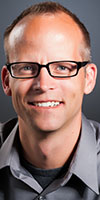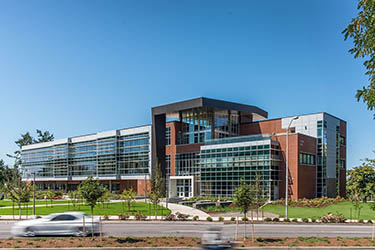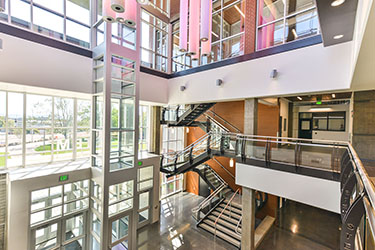|
Subscribe / Renew |
|
|
Contact Us |
|
| ► Subscribe to our Free Weekly Newsletter | |
| home | Welcome, sign in or click here to subscribe. | login |
Construction
| |
 |
August 25, 2016
Clark College creating a regional hub for STEM
LSW Architects

Wyckoff
|
Students attending Clark College in Vancouver this fall will have access to a new science, technology, engineering and math (STEM) building.
The $40 million, 70,000-square-foot building houses biology, chemistry, engineering, physics and geology programs. The building also features a drop tower for lab experiments, and a six-table cadaver lab for human anatomy observation.
Employer demand
Invention and discovery are engines that drive U.S. competitiveness, quality of life and national security. These engines, in turn, are driven by the scientific and technological advances made possible by the STEM workforce.
The Clark College STEM building will serve as a regional hub for STEM education, deepening the future talent pool for STEM occupations.
Washington state’s STEM job growth is No. 1 in the nation, and local employers are demanding a larger number of skilled graduates in the areas of STEM. The STEM building is supporting the workforce need by improving the educational offerings at Clark College and by increasing collaboration among programs previously dispersed throughout the Clark College campus. Serving as a destination for the community and K-12 field trips, the facility will build public awareness of STEM education and careers, making the exploration of STEM frontiers an engaging experience.
The building houses 30 classrooms and science labs, and features a technology computer lab, indoor/outdoor study spaces, offices and support areas. The facility will have a daytime capacity of close to 1,000 full-time-equivalent students.
Key design concepts
LSW Architects introduced a number of key design concepts into its design of the STEM building, including abundant natural light, transparency into learning spaces, display and interactivity, and acoustically appropriate environments throughout. Here’s a look at these concepts in greater detail:
• Light and outdoor access: Research proves that quality lighting, specifically daylighting, has positive impacts on student learning and work performance. The STEM building maximizes the neurological, physical and energy savings aspects of daylighting while minimizing any detrimental aspects such as unwanted heat and glare.
A rooftop plaza and an outdoor classroom provide alternative learning and studying venues in an outdoor setting.
• Views: Transparency into learning spaces allows for views of teaching and learning activities, generating additional interest in STEM programs of study. The increase of educational transparency between programs also helps to create a true cross-disciplinary atmosphere.
• Display and interactivity: Designed for use as an educational tool, the building design exposes the science and technology inherent in the infrastructure and support systems. The spaces within and around the building encourage student and faculty interaction and the free exchange of ideas and concepts in STEM.
One such space is the Collaboratorium, a group workspace that students can use for projects and to build experiments. A machining room adjacent to the Collaboratorium further enables students to test their designs.
Another thoughtful design feature is rain gardens that flank the main entry, meant to show students how stormwater infiltrates into the ground.
• Sound: Successful acoustics are vital to the learning process. Areas of circulation benefit from the energy and sound of activity, while learning spaces need to enhance the spoken word and encourage focus. Additional care was given to dedicated and informal learning areas to create acoustically appropriate environments.
• Movement: The building encourages healthy movement of its occupants with easily located stairs, encouraging their use and reserving the elevator for those requiring the accessibility.
Accommodations increase bike and mass transit usage on the campus. Bike racks and lockers rest under cover in secure, centrally located areas.
Green features
The STEM building will host more than just educational activities. A rooftop plaza provides study space for students as well as a beautiful venue for events. The flexible main lobby can expand into an adjacent digital lounge and classrooms to create a large multipurpose space for functions and exhibits when needed.
The project team was committed to building stronger communities through a commitment to sustainability. The STEM building is expected to receive LEED silver certification in part because of the following:
• Recycled waste: 97.5 percent of construction waste was recycled.
• Brownfield redevelopment: The new building replaces an antiquated building that had outlived its useful life, and contributes to improved environmental quality by addressing asbestos contamination in the soil, which was removed from site for remediation prior to construction.
• Reduced water use: Low-flow and sensor-activated plumbing fixtures were selected to achieve a 30 percent reduction in water usage over a standard building.
• Enhanced commissioning: Done to ensure the building systems are functioning as designed.
• Responsible material use: 50 percent of the wood used on the project was certified by the Forest Stewardship Council.
• VOC: Interior finishes were selected meet stringent guidelines for VOC content.
Funding for the project came through the state, but when a 15 percent budget cut hit the project, philanthropic partners of the Clark College Foundation stepped in and contributed the remaining $1.9 million to complete the project.
The official grand opening for the new STEM building will be Oct. 3.
Casey Wyckoff is president of LSW Architects in Vancouver. His professional career focuses on using architecture to support the community.
Other Stories:
- When does renovating a school mean bringing it ‘up to code’?
- New Mount Si High will sit atop 4,800 stone columns
- How to design a school restroom that works for everyone
- School projects in remote Alaskan villages face tall hurdles
- Lynden Elementary: from concept to completion in 22 months flat
- Learning center in Tacoma Park will serve students and the community
- ‘Dark,’ ‘maze-like’ student union gets a big makeover
- Tahoma School District responds quickly to surging enrollment




